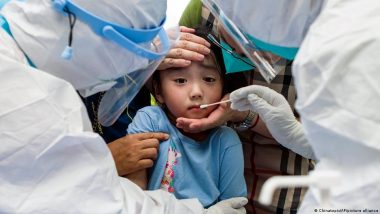Discovering COVID's origin will shape the next pandemic. Scientists think it was either nature's way or accidental leak. There's no consensus. Here's why.Four years after the COVID-19 pandemic provoked whole countries into lockdown, scientists are still trying to find conclusive evidence to pinpoint where the virus first infected humans.
Also Read | Genius Day 2024: Albert Einstein Inspirational Quotes That Will Help You Achieve Greatness.
But does it really matter where SARS-CoV-2, the virus that caused COVID, originated — now that life's back to a kind of normal? What's the difference if the virus leaked from a lab or developed in nature?
Also Read | SpaceX's Mega Rocket Blasts Off on Third Test Flight From Texas (Watch Video).
Well, researchers say it does matter: They say it's one of the most important questions for our understanding of how pandemics start and how we can prevent them in the future.
The answer, they say, would have a lasting effect on health policy, scientific funding, public opinion on science, and diplomatic relations.
Not to mention the fact we're still living with COVID: The World Health Organization (WHO) COVID-19 Dashboard continues to report hundreds of thousands of cases every month worldwide.
But from lab leak theory to zoonotic theory, and conspiracy theories in between, there's no consensus on COVID's origin.
With new investigations and analyses emerging on this fourth anniversary, we take a look at the current thinking.
Did SARS-CoV-2 leak from a lab?
Arguments for the lab leak theory center around the Wuhan Institute of Virology , an institute where scientists were researching coronaviruses at the time of the initial outbreak in China.
"The strongest evidence comes from the timeline of research [going back to] 2012. Published papers from the institute show scientists could construct modified coronaviruses," said Richard H. Ebright, a professor of chemical biology at Rutgers University in the US.
Research included genetically altering coronaviruses to make them stronger — such as adding spike proteins and testing the viruses' ability to spread. Their stated aim was to help prevent coronavirus outbreaks.
But we don't know how many coronaviruses the institute studied. "They refused to collaborate from the start," opined Ebright.
Some experts say it's possible that the Wuhan lab had progenitor strains — ancestors — of SARS-CoV-2, but China's alleged withholding information on the origin of COVID makes this impossible to prove or disprove.
Then there's the question of how the virus would have leaked. Some say it leaked by accident, due to weak security measures at the lab, and other suggest it was intentionally developed and released as a biological weapon. But there is no firm evidence for either theory.
"Every form of the lab leak theory involves some sort of cover up, which to me means that it's a conspiracy theory," said Edward Holmes, a professor of virology at the University of Sydney in Australia.
Did COVID-19 come from nature?
Some scientists prefer the zoonotic theory: The theory that the virus evolved in nature from an existing coronavirus and spread from wild animals to humans at the Huanan Seafood Wholesale Market, also in Wuhan, China.
Researchers said they had analyzed statistical data to locate — what they said — were the first human cases and that those cases were among market vendors who sold live animals.
"The evidence supports a zoonotic origin," said Angie Rasmussen, a virologist at the University of Saskatchewan in Canada. "It includes detailed studies of SARS-CoV-2 [...] and its evolutionary trajectory once [it was in] the human population."
Scientists have studied samples from wild animals in Wuhan for signs of the original SARS-CoV-2 virus. But they have failed to find it. And they have also failed to trace how the virus spread from the market to the outside environment.
"The key step of tracing and testing the animals at the Huanan market was not done [at the time] and it's too late now. For this reason, we have been unable to identify the exact animal ancestry," said Holmes.
But given that Huanan market is 16 kilometers (10 miles) from the Wuhan Institute of Virology, some people continue to suggests that the lab and/or the market were COVID's epicenter.
COVID's origin: tending towards nature?
An expert survey in February 2024 found that most scientists believe COVID emerged from nature.
The expert respondents gave the natural, zoonotic (or zoonosis) theory an average likelihood of 77% — four out of five of the experts said it was more than 50% likely. But the experts said there was a 21% likelihood that COVID started due to "research-related accident" — one out of five of the experts said there was a 50% or greater chance of that.
"When you take other intelligence into account, the lab leak theory starts to seem more plausible," said Seth Baum of the Global Catastrophic Risk Institute, which co-published the survey with Nemesys Insights.
When Baum refers to "other intelligence," he's talking about non-scientific factors, such as proximity of the market to the lab.
Much of the evidence that might provide a conclusive answer, however, has been lost or remains unavailable for public scrutiny.
"Whether we'll get an evidence-based conclusion depends on countries like China collaborating and being forthcoming with data," said Baum.
The one thing experts do agree on is that we need to keep trying to solve the mystery of COVID's origin — it may determine how we respond to next pandemic.
Edited by: Zulfikar Abbany
(The above story first appeared on LatestLY on Mar 14, 2024 09:10 PM IST. For more news and updates on politics, world, sports, entertainment and lifestyle, log on to our website latestly.com).













 Quickly
Quickly













 RCB
RCB







